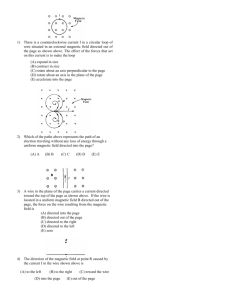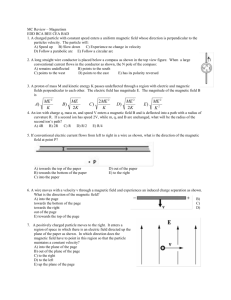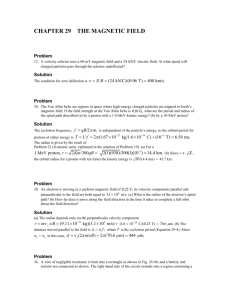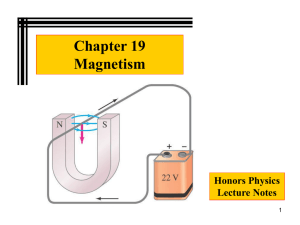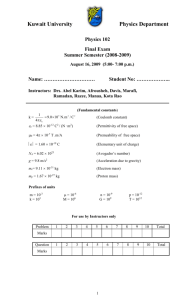(摘自Principles of Physics 9 edition)
advertisement
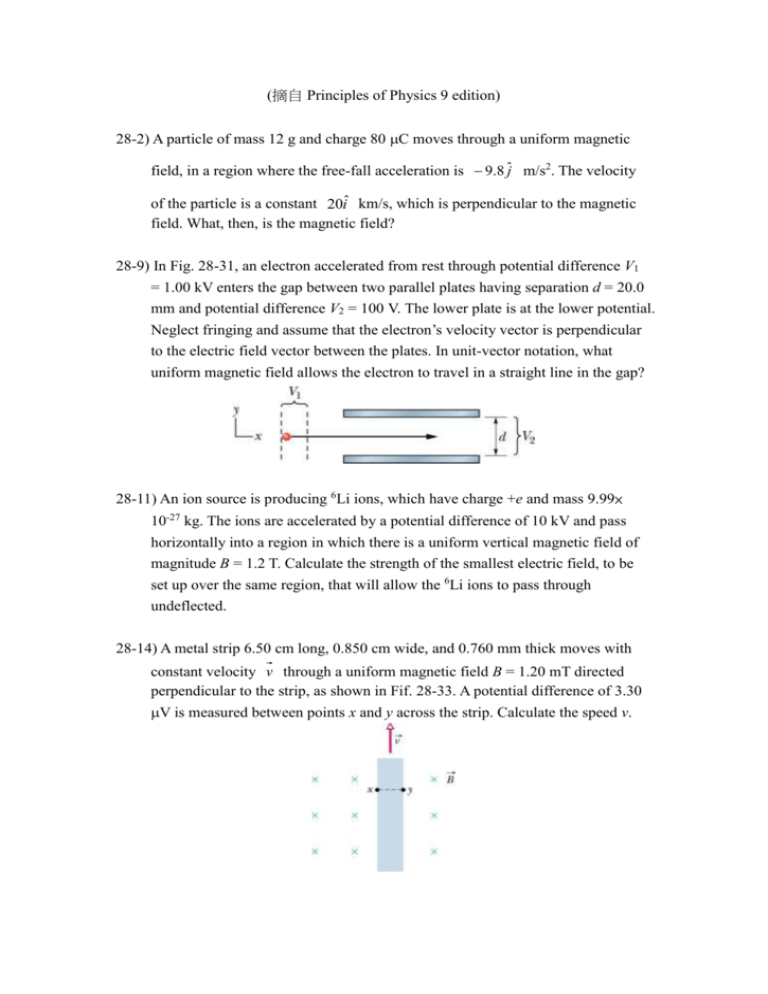
(摘自 Principles of Physics 9 edition) 28-2) A particle of mass 12 g and charge 80 C moves through a uniform magnetic field, in a region where the free-fall acceleration is 9.8 ĵ m/s2. The velocity of the particle is a constant 20iˆ km/s, which is perpendicular to the magnetic field. What, then, is the magnetic field? 28-9) In Fig. 28-31, an electron accelerated from rest through potential difference V1 = 1.00 kV enters the gap between two parallel plates having separation d = 20.0 mm and potential difference V2 = 100 V. The lower plate is at the lower potential. Neglect fringing and assume that the electron’s velocity vector is perpendicular to the electric field vector between the plates. In unit-vector notation, what uniform magnetic field allows the electron to travel in a straight line in the gap? 28-11) An ion source is producing 6Li ions, which have charge +e and mass 9.99× 10-27 kg. The ions are accelerated by a potential difference of 10 kV and pass horizontally into a region in which there is a uniform vertical magnetic field of magnitude B = 1.2 T. Calculate the strength of the smallest electric field, to be set up over the same region, that will allow the 6Li ions to pass through undeflected. 28-14) A metal strip 6.50 cm long, 0.850 cm wide, and 0.760 mm thick moves with constant velocity v through a uniform magnetic field B = 1.20 mT directed perpendicular to the strip, as shown in Fif. 28-33. A potential difference of 3.30 V is measured between points x and y across the strip. Calculate the speed v. 28-18) In Fig. 28-35, a particle moves along a circle in a region of uniform magnetic field of magnitude B = 5.00 mT. The particle is either a proton or an electron (you must decide which). It experiences a magnetic force of magnitude 3.20× 10-15 N. What are (a) the particle’s speed, (b) the radius of the circle, and (c) the period of the motion? 28-26) In Fig. 28-38, a charged particle moves into a region of uniform magnetic field B , goes through half a circle, and then exits that region. The particle is either a proton or an electron (you must decide which). It spends 160 ns in the region. (a) What is the magnitude of B ? (b) If the particle is sent back through the magnetic field (along the same initial path) but with 2.00 times its previous kinetic energy, how much time does it spend in the field during this trip? 28-38) In a certain cyclotron a proton moves in a circle of radius 0.500 m. The magnitude of the magnetic field is 1.00 T. (a) What is the oscillator frequency? (b) What is the kinetic energy of the proton, in electron-volts? 28-46) In Fig. 28-43, a metal wire of mass m = 24.1 mg can slide with negligible friction on two horizontal parallel rails separated by distance d = 2.56 cm. The track lies in a vertical uniform magnetic field of magnitude 73.5 mT. At time t = 0, device G is connected to the rails, producing a constant current I = 9.13 mA in the wire and rails (even as the wire moves). At t = 61.1 ms, what are the wire’s (a) speed and (b) direction of motion (left or right)? 28-51) Figure 28-45 shows a wood cylinder of mass m = 0.250 kg and length L = 0.100 m, with N = 10.0 turns of wire wrapped around it longitudinally, so that the plane of the wire coil contains the long central axis of the cylinder. The cylinder is released on a plane inclined at an angle to the horizontal, with the plane of the coil parallel to the incline plane. If there is a vertical uniform magnetic field of magnitude 0.500 T, what is the least current I through the coil that keeps the cylinder from rolling down the plane? 28-55) Two concentric, circular wire loops, of radii r1 = 20.0 cm and r2 = 30.0 cm, are located in an xy plane; each carries a clockwise current of 7.00 A (Fig. 28-47). (a) Find the magnitude of the net magnetic dipole moment of the system. (b) Repeat for reversed current in the inner loop. 29-4) A straight conductor carrying current I = 5.0 A splits into identical semicircular arcs as shown in Fig. 29-35. What is the magnetic field at the center C of the resulting circular loop? 29-24) Figure 29-51 shows, in cross section, four thin wires that are parallel, straight, and very long. They carry identical currents in the directions indicated. Initially all four wires are at distance d = 15.0 cm from the origin of the coordinate system, where they create a net magnetic field B . (a) To what value of x must you move wire 1 along the x axis in order to rotate B counterclockwise by 30 ? (b) With wire 1 in that new position, to what value of x must you move wire 3 along the x axis to rotate B by 30 back to its initial orientation? Ans. 28-2) (0.073 T )kˆ 28-9) B (2.67 104 T)kˆ 28-11) 6.8×105 V/m 28-14) 0.382 m/s 28-18) (a) 3.99×106 m/s (b) r = 0.00454 m (c) T = 7.14 10–9 s 28-26) (a) 0.205 T (b) 160 ns 28-38) (a) 1.53×107 Hz (b) 1.19×107 eV 28-46) (a) 4.36×10-2 m/s (b) left 28-51) 2.45 A 28-55) (a) 2.86 Am2 (b) 1.10 Am2 29-4) BC = 0 29-24) (a) x = 7.0 cm (b) x = +7.0 cm

